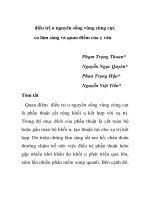Ca lâm sàng và tổng quát y văn về truyền máu thai nhi trong tử cung_Tiếng Anh
Bạn đang xem bản rút gọn của tài liệu. Xem và tải ngay bản đầy đủ của tài liệu tại đây (1.26 MB, 22 trang )
<span class='text_page_counter'>(1)</span><div class='page_container' data-page=1>
Intrauterine blood
transfusion: a case
report and literature
review
Nguy
Bruno Schaub MD
ễ
n Ng
ọ
c Tú MD
Nguy
ễ
n Qu
ố
c Tu
ấ
n Vice
Prof, PhD
</div>
<span class='text_page_counter'>(2)</span><div class='page_container' data-page=2>
Introduction
First fetal blood transfusion was
performed by professor William Liley in
1960s.
One of the most successful fetal
</div>
<span class='text_page_counter'>(3)</span><div class='page_container' data-page=3>
Case report
22 year old woman, G1P1, normal vaginal delivery
History: unremarkable
1st trimester ultrasound scan: normal NT, 2nd trimester
ultrasound scan at 22w: normal.
</div>
<span class='text_page_counter'>(4)</span><div class='page_container' data-page=4>
Ultrasound
Asci
</div>
<span class='text_page_counter'>(5)</span><div class='page_container' data-page=5>
Ultrasound
Thickened
</div>
<span class='text_page_counter'>(6)</span><div class='page_container' data-page=6>
Blood test
Hb electrophoresis HbA1 98,1%; HbA2 1.9%
Hgb 129 g/l; RBC 4,6 T/l; PLT 91 G/l
The test for 20 common mutations in alpha thalassemia genes
showed no mutation.
Blood type B Rh+
</div>
<span class='text_page_counter'>(7)</span><div class='page_container' data-page=7>
Procedure
</div>
<span class='text_page_counter'>(8)</span><div class='page_container' data-page=8>
Follow-up
</div>
<span class='text_page_counter'>(9)</span><div class='page_container' data-page=9>
Follow-up
</div>
<span class='text_page_counter'>(10)</span><div class='page_container' data-page=10>
Follow-up
</div>
<span class='text_page_counter'>(11)</span><div class='page_container' data-page=11>
Follow-up
</div>
<span class='text_page_counter'>(12)</span><div class='page_container' data-page=12>
After birth
Petechial rash, hepatomegaly,
splenomegaly
Test: Hgb 62 g/l
The fetus was received a
transfusion of 36ml packed red
cells
</div>
<span class='text_page_counter'>(13)</span><div class='page_container' data-page=13>
After birth
Petechial rash, hepatomegaly, splenomegaly
Test: Hgb 62 g/l
The fetus was received a transfusion of 36ml
packed red cells
</div>
<span class='text_page_counter'>(14)</span><div class='page_container' data-page=14>
discussion
Feral anemia is an inadequate
number or quality of RBCs in fetal
circulatory system.
Hypoxia causes tissue damage.
As the heart works harder,
eventually lead to cardiomegaly,
fetal hydrops and fetal death.
</div>
<span class='text_page_counter'>(15)</span><div class='page_container' data-page=15>
Cause
RBC alloimmunization (mostly
Rh)
Fetal infection, TAPS in MCDA,
Thalassemia disease...
</div>
<span class='text_page_counter'>(16)</span><div class='page_container' data-page=16>
Fetal blood transfusion
Perform from 18 to
35 week
Mari G et al, 2000
Perform after anemia diagnosed
</div>
<span class='text_page_counter'>(17)</span><div class='page_container' data-page=17>
Fetal blood transfusion
Atracurium and Fetanyl
Needle 20-22G
</div>
<span class='text_page_counter'>(18)</span><div class='page_container' data-page=18>
Discussion
This case symptoms suggest a diagnosis of
Parvovirus B19 infection.
Parvovirus B19 is accounted for 27% of
cause in non-immune fetalis hydrops(*)
Postnatal anemia proved the diagnosis
Postnatal blood transfusion is necessary in
50% cases.
</div>
<span class='text_page_counter'>(19)</span><div class='page_container' data-page=19>
Discussion
Close surveilliance of MCA Doppler after transfusion
If MCA PSV > 1.69 MoM, indication for the 2nd
transfusion(*)
After the transfusion, fetal status remained stable
But the cardiomegaly was remained and the baby had a
mild coarctation of the aorta
After 3 months, the heart became normal.
</div>
<span class='text_page_counter'>(20)</span><div class='page_container' data-page=20>
Complications
Fetal bradycardia (4%), haemorrhage
at the needle inserted side(5%)
Fetal death 0,6%
Infection and PROM 0,1%
Emergency C-section 0,4%
Survival rate after the transfusion
90%(*)
</div>
<span class='text_page_counter'>(21)</span><div class='page_container' data-page=21>
Conclusion
One of the successful techniques in fetal
intervention.
Assessment of the fetal anemia, after
</div>
<span class='text_page_counter'>(22)</span><div class='page_container' data-page=22></div>
<!--links-->









